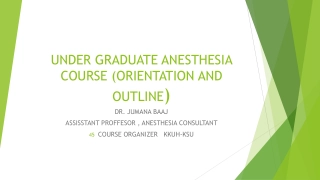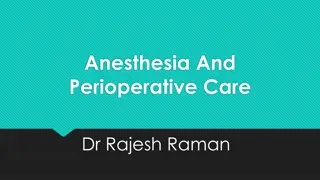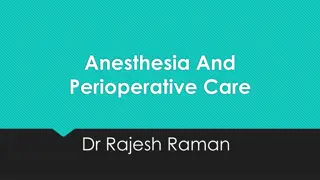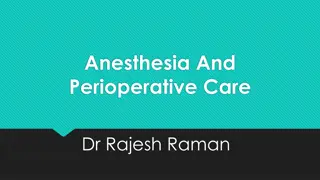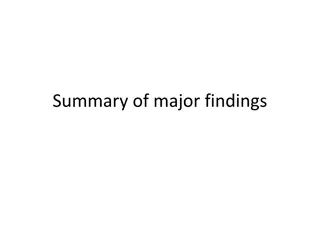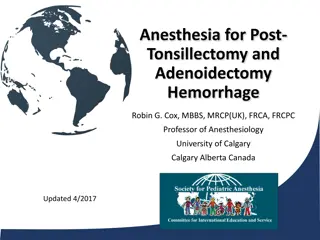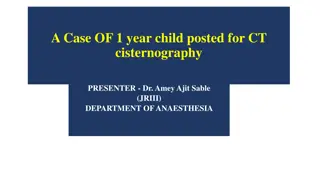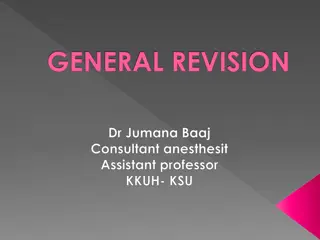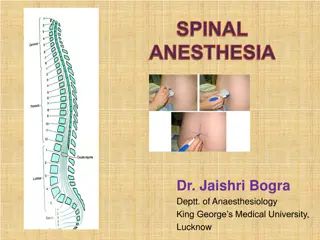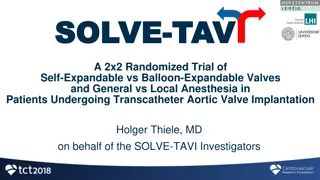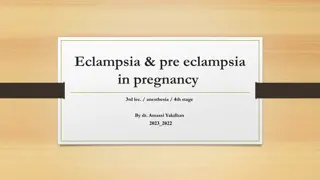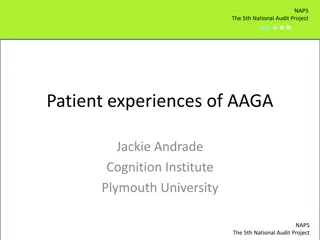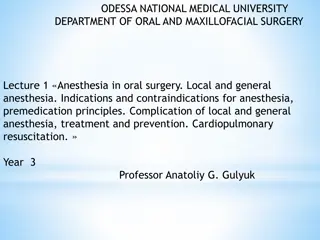Preoperative Assessment of Patients for Anesthesia: Guidelines and Protocols
Efficient preoperative assessment is crucial to ensure patient safety and optimal outcomes during anesthesia administration. This process involves thorough history taking, physical examination, evaluation of medical conditions, and planning for anesthesia techniques. The assessment helps in identifying risks, developing management plans, and reducing perioperative complications. The anesthetic plan includes preoperative, intraoperative, and postoperative management strategies to ensure patient comfort and safety throughout the anesthesia process.
Download Presentation

Please find below an Image/Link to download the presentation.
The content on the website is provided AS IS for your information and personal use only. It may not be sold, licensed, or shared on other websites without obtaining consent from the author. Download presentation by click this link. If you encounter any issues during the download, it is possible that the publisher has removed the file from their server.
E N D
Presentation Transcript
Assessment of patients before anaesthesia By: Dr : Miaad Adnan FIBMS Anaesthesia Dr : Bassim mohammed MSc anesthesia & intensive care 1st lecture/ 3rd stage/ anesthesia technology 2022 - 2023
1 Purpose of preoperative evaluation ? Doctor-patient relationship Surgical procedure Preoperative Preparation Plan of Anesthetic Technique Perioperative risk determination. Coexisting medical conditions Perioperative risk determination. Develop a management plan for perioperative anesthetic care Reduce peri-operative morbidity and mortality Reduce patient anxiety Obtain informed consent
2 The anesthetic plan : Type of anesthesia : Neuroaxial or regional or local anesthesia Technique General Sedation Supplemental oxygen Airway management Induction Drugs Drugs Maintenance Muscle relaxation
3 The anesthetic plan : 1 - Preoperative management 1. History 2. Physical examination 3. Evaluation of coexisting disease 4. Preop lab and diagnostic investigations 5. Preop medication management 6. Anesthetic note 7. Guideline for NPO status
4 The anesthetic plan : 2 - Intraoperative management Monitoring Positioning Fluid management Special techniques 3 - Postoperative Pain control Intensive care * Postoperative ventilation * Hemodynamic monitoring
5 1 . History : History and physical examination are the most important assessors of disease and risk. General history History of 1- Coexisting medical illnesses 2- Medications, present therapy 3- Allergies and drug reactions 4- tobacco and alcohol intake Previous anesthetics, surgeries, deliveries Family History Last oral intake
6 1 . History : Cardiovascular system Specific enquiries must be made about: - Angina incidence precipitating factors duration use of anti-anginal medications, e.g. glyceryl trinitrate (GTN) oral or sublingual ) - Previous myocardial infarction (MI) and subsequent symptoms - Symptoms indicating heart failure
7 1 . History : Cardiovascular system - myocardial infarction are at a greater risk of perioperative re-infarction - Elective surgery postponed until at least 6 months after the event - Untreated or poorly controlled hypertension (diastolic consistently > 110 mmHg) may lead to exaggerated cardiovascular responses - Both hypertension and hypotension can be precipitated which increase the risk of myocardial ischemia
8 1 . History : Cardiovascular system - Heart failure will be worsened by the depressant effects impairing the perfusion of vital organs - Valvular heart disease * prosthetic valves may be on anticoagulants need to be stopped or changed prior to surgery * Antibiotic prophylaxis
9 1 . History : Active Cardiac Conditions Unstable coronary syndromes - Unstable or severe angina - Recent MI Decompensated HF Significant arrhythmias Severe valvular disease
10 1 . History : Minor Cardiac Predictors Advanced age (>70) Abnormal ECG -LV hypertrophy -LBBB -ST-T abnormalities -Rhythm other than sinus Uncontrolled systemic hypertension LBBB. Left bundle branch block
11 1 . History : Surgical Risk Stratification High Risk Vascular (aortic and major vascular) Intermediate Risk Intraperitoneal and intrathoracic , carotid, head and neck, orthopedic, prostate Low Risk Endoscopic, superficial procedures, cataract, breast, ambulatory surgery
13 1 . History : Respiratory system Patients with pre-existing lung disease postoperative chest infections if they are obese or undergoing upper abdominal or thoracic surgery Chronic obstructive lung disease production of sputum (volume and color) Dyspnea Asthma, including precipitating factor Upper respiratory tract infection anaesthesia and surgery should be postponed unless it is for a life-threatening condition
15 1 . History : Family history All patients should be asked inherited conditions in the family history of prolonged apnoea unexplained death malignant hyperpyrexia Surgery postponed
16 1 . History : SOCIAL HISTORY Smoking number of cigarettes amount of tobacco Alcohol induction of liver enzymes tolerance Pregnancy increased risk of regurgitation and aspiration Elective surgery is best postponed until after delivery.
American Society of Anesthesiology Risk Classification American Society of Anesthesiology Risk Classification
18 2 - Physical examination : General History Physical examination Evaluation of coexisting disease Preop lab and diagnostic investigations Preop medication management
19 2 - Physical examination : * Vital signs, (CNS, heart, lung,) * Airway, * If regional anaesthesia is proposed - Assessment of the site of block - Back
20 2 - Physical examination : vital signs Blood pressure Resting pulse - rate, rhythm Respiration - rate, depth, and pattern at rest Body temperature Pain score
Airway Assessment Airway Assessment Predictors of difficult intubation Mallampati classification ULBT (upper lip bite test) Inter-incisors gap (IID) Thyromental distance (TMD) Forward movement of mandible Document loose or chipped teeth Tracheal deviation Movement of the Neck
Mallampati test Class I = visualize the soft palate, uvula, anterior and posterior pillars. Class II = visualize the soft palate and uvula. Class III = visualize the soft palate and the base of the uvula. Class IV = soft palate is not visible at all.
Interincisor distance (IID) Less than or equal to 4.5 cm is considered a potentially difficult intubation. Generally greater than 2.5 to 3 fingerbreadths (depending on observers fingers)
Sterno-mental Distance (SMD) Extended head and neck, mouth closed, distance <12.5cm is a difficult intubation
CRANIOFACIAL DEFORMITIES Temporomandibular joint protrusion of mandible
Preoperative Laboratory Testing Preoperative Laboratory Testing only if indicated from the preoperative history and physical examination. Blood test CBC anticipated significant blood loss, suspected hematological disorder (eg.anemia, thalassemia, SCD), or recent chemotherapy. Complete blood count:- Red blood cells(RBC), which carry oxygen White blood cells(WBC), which fight infection Hemoglobin(Hb), the oxygen-carrying protein in red blood cells Hematocrit (HCT), the proportion of red blood cells to the fluid component, or plasma, in blood Platelets (PLT), which help with blood clotting
Clotting Screen Clotting Screen PT, INR, PTT PT, INR, PTT 9.5-13.5 seconds indication: any deranged coagulation, such as: iatrogenic causes (e.g. warfarin), inherited coagulopathies (e.g haemophilia 0.7-1.2 A/B) liver impairment. 25 35 seconds Surgery with expected blood loss.
Urea & Electrolytes Urea & Electrolytes (U&Es) and creatinine To assess the baseline renal function, which help inform any potential IV fluid management intra- and post-operatively COMMON ELECTROLYTES INCLUDE: Chloride (CL) : 95-105 mmol/L Sodium Na: 135-145 mmol/L Creatinine: 0.8-1.3 mg/dL Urea: 7-30 mg/dL Potassium (K) : 3.5-5 mmol/L Uric acid: 3.5-7.2 mg/dL Total calcium: 8.5-10.2 mg/dL Inorganic phosphorous: 2.8-4.5 mg/dL Magnesium: 1.5-2 mEq/L Ionized calcium: 4.8-5.5 mg/dL Glucose: 65-110 mg/dL
Investigations ECG age >50 yrs ,history of cardiac disease, hypertension, peripheral vascular disease. It can indicate any underlying cardiac pathology and provide a baseline if there are post-operative signs of cardiac ischaemia. An echocardiogram (ECHO) may be considered if the person has: (1) a heart murmur (2) cardiac symptom(s) (3) signs or symptoms of heart failure. Chest X-rays prior cardiothoracic procedures ,COPD, asthma, recently resolved respiratory tract infection , a change in respiratory symptoms in the past six months, stable cardiac disease, smoking, and extremes of age.
(VC). Pulmonary function tests (PFTs) are a group of tests that measure how well your lungs work. This includes how well you re able to breathe and how effective your lungs are able to bring oxygen to the rest of your body RV ERV VT. IRV. VC. Functional residual capacity (FRC). 2300ml Total lung capacity TLC 5800 ml.
25 2 - Physical examination : Cardiovascular system Dysrhythmias Atrial fibrillation Heart failure Heart murmur Valvular heart disease Blood pressure is best measured at the end of the examination
2 - Physical examination : 26 Respiratory system cyanosis pattern of ventilation respiratory rate RR Dyspnoea Wheeziness signs of collapse consolidation and effusion
2 - Physical examination : 27 Nervous system Chronic disease of the peripheral and central nervous systems evidence of motor or sensory impairment recorded dystrophic myotonica Musculoskeletal restriction of movement and deformities reduced muscle mass peripheral neuropathies pulmonary involvement Particular attention to the patient's cervical spine and temporomandibular joints
29 3-Evaluation of coexisting disease: Cardiovascular disorders : Hypertension, Ischemic heart disease, Heart failure, Valvular heart disease, Patients with rhythm disturbances, Patient with coronary stents, Patients with pacemakers and ICD devices, Patients with peripheral arterial disease Pulmonary disorder Upper respiratory tract infection, Asthma and COPD, Chronic smokers, Restrictive lung diseases,Obstructive sleep apnoea(OSA), Patients scheduled for lung resection
31 3-Evaluation of coexisting disease: Endocrine system Diabetes Mellitus, Thyroid disorders, Hypothalamic- pituitary- adrenal disorders, Pheochromocytoma Diabetes Mellitus Diabetes : control blood sugar CVS - HT, myocardial ischemia CNS - stroke, weakness, autonomic neuropathy peripheral neuropathy GI gastro paresis Stiff joint : cervical spine, TM joint
33 3-Evaluation of coexisting disease: GIT system Liver disease Gastroesophageal reflux symptom increase risk of pulmonary aspiration renal system Surgical stress, anaesthetic agents tend to decrease GFR * Renal impairment - CKD - AKI * Contrast induced nephropathy * The emphases of the preoperative evaluation of patients with renal insufficiency are on the cardiovascular system, cerebrovascular system, fluid volume, and electrolyte status
39 7- NPO :
39 you thank






